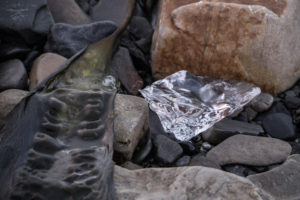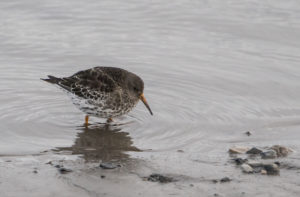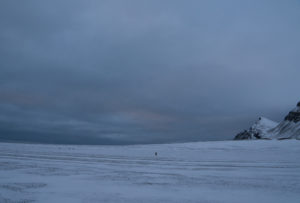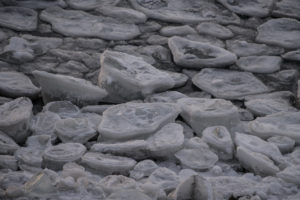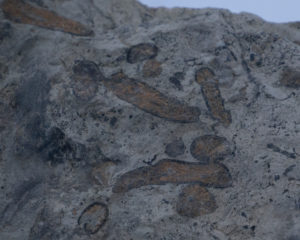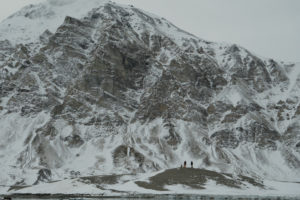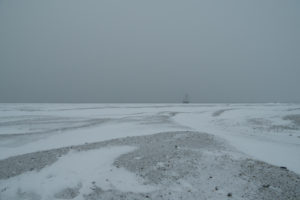by aramatzne@gmail.com | 25 Feb 2019 | Roads Taken
The beginning

Afternoon light and cloud shadows play on snowy mountains.
As you may know, in October 2018, I spent three weeks in the Norwegian archipelago of Svalbard as a member of The Arctic Circle, an annual expeditionary residency program. Sailing from the town of Longyearbyen on the three-masted Barquentine ship, Antigua, we explored the coast and fjords, the light, textures, sounds, and landscapes, following the western edge of Spitsbergen, the largest and only permanently populated island of the archipelago, to the south and to the north and back again to Longyearbyen. In between, we motored; we sailed, putting up and pulling down sails; we ate and laughed; we heard stories of our shipmates, the residents, and the crew; we explored on foot, in the Zodiac, in the ship; we saw reindeer and seals, a handful of birds, polar bear tracks and snow angels; we heard glaciers; we watched the sun revolve around the horizon morning to night and again; we saw the aurora; it snowed, it rained, it was cold, windy, foggy, and raw; it was sunny, blue, and gorgeous; the water was calm and it was not; and day by day, we lost daylight as we revolved our way closer to the Polar Night and winter. And day by day, we lost, in the smallest modern human-pampered-on-a-ship way, what it meant to be separate from the landscape.
There is a lot to tell in this tale. And there is a lot that I cannot express, neither through words nor in my photographs. I kept a journal, of course, but it is perfunctory. I was too enthralled and engaged with the place and the people, too overloaded with the intensity of the space. My introverted anti-social self was in way over my head. Finding calm headspace to reflect and express the experience did not happen for me on board. And writing onshore in the cold and wet, well, many of you know my handwriting. In the months (!) since I meandered in and out of my photos, racing through them initially to share what may be of interest to the rest of the residents and crew, I bogged down when it came time to express the meat of the place in my images.
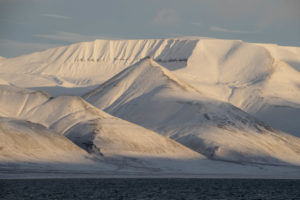
Arctic geometry: angles, triangles, and plane plains.
Via email, I lamented to my sweet friend Linda that I was not keeping up with my blog, ideas were percolating but I was reluctant to put them on paper or into the ether. Her response, “my sense is that you saw too much, know too much and hurt too much. Your slowness in letting it out is, I believe, more kind to us who think it’s going to hurt us too much.”
My lazier self says, yes, I am being kind. My practical self knows not where to begin or how to convey the mesmerizing passage of time and light in a place known for cold and dark. And, as this place passes from our memory in the years of melting ahead, I will mourn, as with all things, not for its passing but for my loss. For our loss. For all those who will not know it and who will wonder at its very existence. Like the miles-long herds of bison and the days-long flights of passenger pigeons, the Arctic is fading.
I don’t believe that we alone are entirely to blame, the planet has long worked in its own mysterious ways, but in no way have we helped. Exploiting everything we could for centuries, erasing landscapes for coal and oil, eliminating people and their ways of life, executing populations of fish and animals for our endless, grinding consumption, we certainly carry the brunt of the shame.
And so, I start the only place I can, with my experience and impressions. Like the Cooper Island series previously posted here, over the coming months I will share my journal, photos, and thoughts. I hope you’ll tag along.
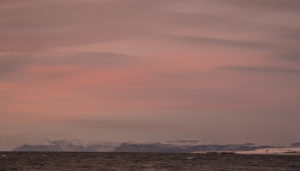
Pastels meet mountains and sea.
by aramatzne@gmail.com | 2 Nov 2018 | Roads Taken

Afternoon shadows on the mountains of Norde Isfjorden National Park, Svalbard.
Confession
I am reluctant to write about Svalbard and the Arctic. The place is so far removed from the usual and from the expectations of the norm that it is difficult to describe.
I have had a few conversations with people where pieces of the whole leaked out, like secrets I was not meant to share. And the response was as anticipated – the ideas, the images were so beyond recognition and understanding as to be preposterous.
Like rumors, gossip that is not unheard of but beyond credibility. The Arctic and the small corner of Svalbard that I saw fall into this category.
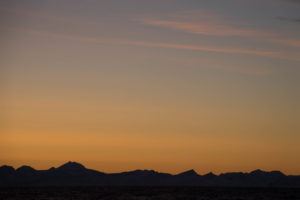
The colors of autumn in an October sunset over Spitsbergen.
The mountains rise directly from the sea and the fjords unimpeded by beaches or plains; the glaciers grind down the mountains and valleys. The sky extends beyond the imagination in colors that don’t exist in other realms. The atmosphere is both clearer and thicker, which seems counterintuitive and contradictory. The sun is never overhead – even in summer, it circles the horizon at a stubbornly low angle. Setting in late October and not rising again until mid-February it begrudgingly offers light for eight months a year. Graciously, however, it bestows the same amount of light in the year that the rest of the globe receives. When there are snow and ice, the colors of the sky offset the monochrome palette of mountains and rocks. Distance is deceptive and what appears just across the tundra may be hours away. Mountains loom above the water, glaciers loom above the people, and the sky wraps us all into its folds indiscriminately.
Challenge
Does the Arctic feel my absence the way I feel its? No. The land is indifferent to me. The Arctic does not suffer fools lightly, and only a fool would go to the Arctic for a few weeks thinking that was enough.
To say I am changed is trite. To deny it is folly. My challenge now is to express what seeped into my consciousness and spirit without losing the essence of the experience, without giving in to hyperbole and empty words.
by aramatzne@gmail.com | 30 Sep 2018 | Roads Taken
Town
I understand now that the sun is too low on the horizon to clear the mountains around Longyearbyen; I look forward to sailing into the sunshine on Monday. Below are a few more shots around town.
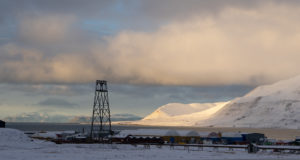
Sunshine so far away.
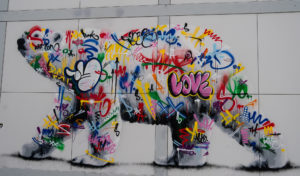
A stylish/stylized/styling polar bear all dressed up for a day on the town.
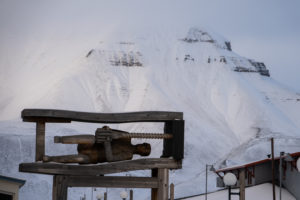
The unknown miner drills into mid-town coal reserves.
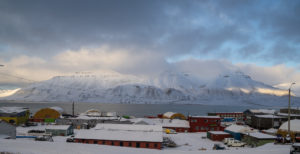
Sun catches both ends of the mountains across the fjord but stays out of town this time of year.
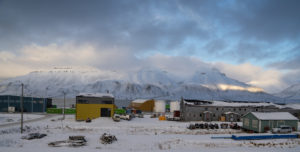
The mountains across Isfjorden catch a few late afternoon rays.
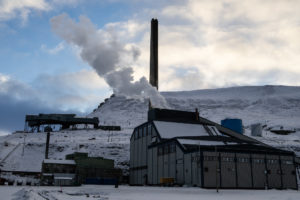
The old coal cableway looks down upon the current power plant. No indication of what keeps the new plant firing.
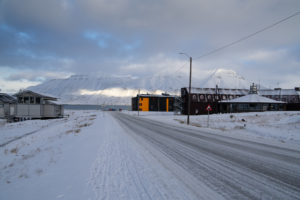
All roads lead to Isfjorden and views of Nordre Isfjorden National Park beyond.
by aramatzne@gmail.com | 3 Sep 2018 | Musing
Then
Cooper Island seems a lifetime ago, the light, the endless bird calls, the sand, the cold and eternal, infernal wind. They are far away now. I returned to Cooper the following summer for a shorter stay, and after demanding a wall tent in which I could stand up and be out of the wind simultaneously. By then George met Darcy Frey and the momentum of Cooper drastically increased as Darcy visited the island, interviewing George and me; later Joe McNally came to photograph Cooper and its residents, avian and otherwise. The story was published in the New York Times Sunday Magazine, George Divoky’s Planet, in 2002. Climate change was under debate (yes, even then and even still) and George’s 30-year data set was a prime source of intrigue. The birds George studied definitively returned to their mutual island almost two weeks earlier than when he began summering, and I use the term loosely, on Cooper Island.
Black Guillemots are cavity nesters; when the winter’s snow and ice retreat sufficiently to allow birds to enter their cavities, make it cozy, and spend time, well, nesting, they return. First, there are some flybys, birds stay in the air, doing visual reconnaissance; how much snow is there on their chosen sand spit? Are the nest sites visible? Flybys become fleeting landings, a strut or two along the ground or a momentary claiming of the nest box, snow preventing entering but exposure allowing dibs, if you will. Finally, birds arrive in droves, the mating rituals begin, and the birds settle into family life, breeding, eggs, chicks, frenetic but fleeting teenage days, and fledging. All racing against the spin of the Arctic seasons that until recently favored the dark, cold months.
As the climate continues to change and shift in ways we mere mortals can only guess, the birds long ago began to play the odds, returning earlier with the expectation that their summer homes will be open and inviting earlier this year than last. And, of course, we, mere mortals, are responsible for the Guillemots’ extended summering. Argue what you like, the world is changing and the creatures we so readily dismiss as animals are way ahead of us in understanding and appreciating the implications. They may not discuss it in political terms or devise computer models to help predict their future, but they recognize the current, if limited, advantage or disadvantage that it presents.
As Guillemots nest earlier each decade, polar bears are forced off the ice as it disintegrates beneath them. Traditionally following the ice north through summer, bears are left swimming farther than possible or are forced to be land-bound through summer. Their lives are made by the heavy winter cold and the extensive pack ice on which they travel and hunt. The small gain for guillemots is an enormous loss for polar bears. And, yes, polar bears are a more charismatic species receiving more attention, but, of course, the world is a poorer place for the loss of any species.
While being able to nest a few weeks early appears beneficial on the surface, the reality is Guillemots feed along the ice pack edge. As eggs are laid, and chicks develop, overworked Guillemot parents repeatedly fly to the pack ice to feed themselves and return to Cooper with one fish at a time for their growing young. When the pack ice is near, this equals fat and happy chicks with plenty of Arctic cod to help them grow toward fledging. As the pack recedes from shore and the distance increases, chicks feed less often; parents burn more of their strength commuting and are sometimes required to shift to less desirable forage fish. The location of the ice can change many times through a season; but as the overall size of the pack decreases, the time it is within range of the breeding colony can also decrease.
Now
At times in the past, pack ice was sometimes far offshore and the colony had a dismal showing for the summer’s work. But Guillemots are long-lived birds and the following year provided new opportunities. Now, pack ice consistently does not form as early, nor stay as late. It is not as thick; it retreats farther from shore. It breaks up earlier and provides a less cohesive mass. Being far offshore is the norm, rather than the exception. All of this potentially leads to reduced fitness and productivity.
Where am I going with this? These small threads simply laid out here are the tiniest fraction of all the pieces that fit together to make our world what it is. The intricacy of connections, circumstances, and continuity is, with all of our advanced science and knowledge, still mostly guessed. Each discovery is accompanied by dozens of questions. For all of our bluster and arrogance, we are repeatedly humbled by findings that take us to new places and show us the error of our previous certainties (think blood-letting, asbestos, and nuclear weapons).
To tie some of these threads together for myself, I am embarking on a residency to Svalbard, a Norwegian territory east of Greenland and above the Arctic Circle. Relative to Cooper, many things are different: it is an archipelago, it will be autumn, it will be dark most of the day, and colder than Cooper in summer, the chaotic summer life will have moved south by the time I arrive. The world and I are 18 years older. I see this as the next phase in the Cooper process, a progression of seasons being redefined as we live them.
As I was writing this, I briefly lost the post in the ether; saving the draft returned a blank page. After much swearing, and an impossible attempt to string the ones and zeros of my words together again, I found the draft invisibly saved in the blog menu. Now, this occurrence neatly ties my thoughts together.
What do we know of the fabric of the Arctic? What do we know of things lost and what can we surmise from the departed? What happens when the richly wrought landscape becomes a blank page? There is no backup menu or replacement post. It is there, or it is not. Much like the lost post, how the threads unravel and disintegrate into the void, is unknown. What we do know is that stringing new ones and zeros together in a way that resembles the original is impossible.
I would be delighted to have you join me virtually for the trip to Svalbard. There is much to be learned and explored. There is much more to the natural world than ones and zeros.




